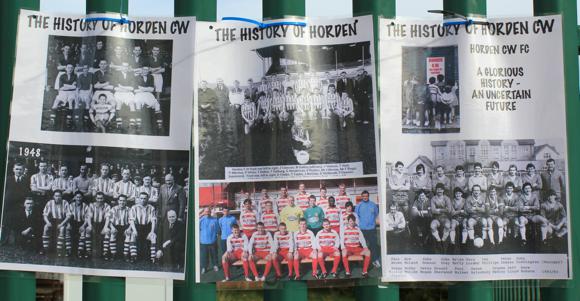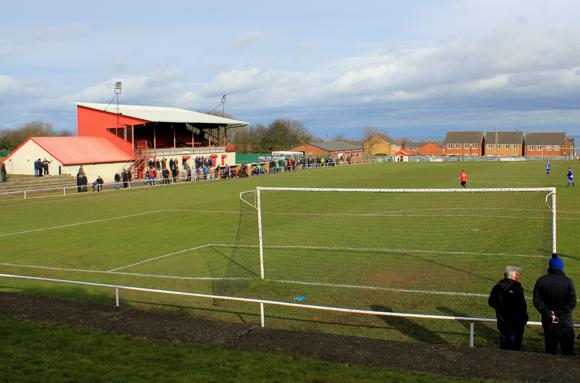This Tuesday, a local parish council will decide the fate of Welfare Park, home of Wearside League team Horden Colliery Welfare since 1908. Andy Potts pays a visit to the ground that spawned two England internationals and potentially several more.
A century-old football ground that witnessed the early careers of England internationals Colin Bell and Stan Anderson may have just seen its last game if a local parish council has its way.
Welfare Park, home to Horden Colliery Welfare AFC since 1908, has been under threat of closure since the ground’s owners announced its repossession on February 17.
Played three days later, Horden CW’s home fixture with Jarrow in the tenth-flight Wearside League may be their final one at Welfare Park.

‘If this is the last game here, at least we signed off with a win,’ said Horden’s Dan Flounders, scorer of two goals in the 3-1 victory before a lively, bumper crowd of 200.
Ironically, the same day that Horden Parish Council issued its recent statement, it also announced the opening of a public sculpture at the same Welfare Park location. Ray Lonsdale’s controversial work, I Ain’t Gonna Work for Maggie’s Farm No More, ‘reflects the devastating effect of pit closures on mining communities throughout the country in the 1980s’.
Horden, County Durham, was once one of Britain’s largest pit villages, mining a rich seam of football talent along with its coal.
In Horden, the council statement continued, ‘…an entire way of life disappeared overnight’. The council purchased the sculpture ‘to honour Britain’s proud mining heritage and core working-class values…’ and is ‘determined that Horden’s roots should be celebrated, linking the past to the present… the best place to site the sculpture is Welfare Park, built for the miners and their families over 80 years ago’.
And yet a crucial meeting this Tuesday, March 1, between the parish council and Horden CW treasurer Ryan Cuthbert could see the end of the club’s venerable football ground. As agreed, the club has already handed over the keys to the council.

‘What happened here in the past, happened in the past,’ said Horden CW committee member Colin Burton after the Jarrow game. ‘There is a good structure here now. We have new people on the committee. We are trying our hardest to make this work. Hopefully we can find a way forward with the council.’
The row is complicated. The club’s previous chairman, Norman Stephens, fell behind on the rent. Some say he was protesting that the council removed the storm-damaged floodlights and, in the process, denied the team any chance of returning to the Northern League. Others recall how he stepped into the breach in 2010, returning to the chair after young entrepreneur Martin Wilson arrived with big plans for the club – only to disappear within months.
In 2013, when the club’s lease on the ground expired, the council refused to negotiate an extension. Last month, a court ruling confirmed that Stephens and former club secretary John Stubbs – both now out of the organisation – were in breach of the lease. The judge agreed that the parish council could take possession of the ground and awarded £82,500 in costs against the two officials.
In response, the club’s new committee has mobilised public opinion. An online petition collected 1,770 signatures in barely a week and has been handed into the council. A social media push helped raise the gate for the Jarrow game, bolstered by a few dedicated groundhoppers from around the country and a reporter from BBC Radio Newcastle.
Suddenly, perhaps belatedly, there’s a recognition of what could be lost if the club is evicted.
At first glance, it’s not obvious why the fate of a small football club really matters. Welfare Park, hemmed in by rows of terraced houses, usually attracts two-figure crowds. The team bumps along in the Wearside League, along with the likes of Spennymoor Town Reserves and Silksworth Colliery Welfare. Never mind being far from the glamour of the Premier League, this is a huge distance from the down-to-earth delights of the Northern Premier.
And yet there is something deeper here. For decades the football team was a release for the community. In a world of backbreaking labour down the mine, interspersed with deep poverty in times of economic strife, football was a way out. That’s why the likes of Bell and Anderson, both born locally, started kicking a football here. Both went on to play for England. Anderson remains the only man to captain the North East’s Big Three while Bell is hailed by many as the finest ever player to don a Manchester City shirt.
There was a time when Chelsea, long before the rouble revolution, came sniffing around this wind-blasted spot on the County Durham coast for talent. They signed up one Stan Edwards in 1949 for the princely sum of £1,200. Edwards’ manager at Horden was Bobby Gurney, Sunderland’s all-time leading scorer, league champion in 1936 and FA Cup winner in ’37.
It’s not just about the players. Football has provided the town with communal entertainment and a sense of identity. Today, for the group of die-hards who take charge of the day-to-day running of the club, it’s a vital part of a community that has been eviscerated by years of neglect following the closure of the colliery in the Thatcher years.
Video footage of the Jarrow game reveals not only scores of fans doing a celebratory Poznan but a decisive run into the box by Horden’s 18-year-old, Sunderland-born Tom Young to earn the corner that produced a Flounders goal. Just as Colin Bell had to start somewhere, so England’s youngsters need clubs like Horden Colliery Welfare.
Perhaps more than communities need statues.



